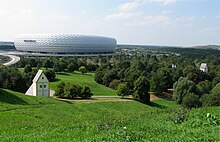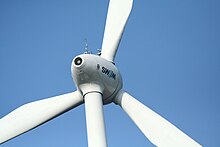Fröttmaninger Berg
The Fröttmaninger Berg is a recreation area on a 75 m high former garbage dump in Fröttmaning on the northern city limits of Munich . It is located in the Freimann district of Munich , on the Munich - Nuremberg motorway (A9) opposite the Allianz Arena . To the northwest is the sister mountain: Landfill North-West . Furthermore, he is surrounded by Kreuz München-Nord , the Munich beltway (A99) , the Freisinger Landstrasse with the Auensiedlung and the Freimann Mosque and the sewage treatment plant Gut Großlappen . The wind turbine at its top is visible from afar ; the Holy Cross Church is a sight at the foot of the mountain.
landfill

The Großlappen landfill was opened in 1954 to recycle and deposit the growing amount of waste that arose during the economic miracle. The nearby Fröttmaning settlement had to gradually give way to the growing mountain of rubbish, except for the church. When the recycling and separation plant burned down in 1965, it was only dumped or burned in the waste incineration plant.
In the 1960s, the environmental problems became more and more serious. A “poison lake” was created on the summit of the garbage mountain, in which chemicals were disposed of, and groundwater pollution increased more and more. Large fires regularly broke out on the mountain of rubbish, dust and stench annoyed residents further away and the mountain of rubbish grew bigger and bigger. A total of 12 million cubic meters of garbage was accumulated.
Renaturation
Partial renaturation began in 1973, but it was not until the 1980s that the mountain was completely greened and the landfill could be closed due to a new landfill and larger waste incineration capacities. In 1985 an underground concrete wall up to 20 m deep was installed to protect the groundwater . At the same time, a degassing system was installed to dispose of the fermentation gases produced . There used to be many fire pits on the mountain when the digester gases were flared off here. The seepage water produced by the rain is collected by a special system, checked for pollutants and fed into the sewage treatment plant . Finally, several layers of earth with a height of two meters were applied.
In 2009 renaturation measures were carried out again because part of the earth layer had slipped.
park
A park landscape with a diverse structure now extends over 35 hectares. Meadows and native woody structures alternate. The main trees on the slopes are: pedunculate oak , spruce, linden, sycamore maple , hornbeam , dogwood , elderberry and eccentric cones . The meadows are tended by extensive sheep grazing. At the foot of the mountain, the runoff water from the slope forms a humid biotope . The Fröttmaninger Berg is an important building block in the biotope network of the area, in particular of the adjacent alluvial forest and the Fröttmaninger Heide .
Recreation
The inhabitants of the north of Munich use the mountain for walks and bike rides, and a playground for children has also been created. In winter it is used as a toboggan hill . It was planned to build a winter sports area with three lifts on the mountain, which should go into operation in winter 2012/2013. However, this project has not yet been implemented. The construction of a new quad chairlift and the resumption of ski operations are planned for the winter of 2018/2019 .
Holy Cross Church
With the Heilig-Kreuz-Kirche, built at the beginning of the 13th century, the oldest surviving church building in the city of Munich is located on Fröttmaninger Berg. Between 1960 and 2006, several citizens' initiatives saved the church from various building projects.
Art installation "Sunken Village"
The art installation Sunken Village by the artist Timm Ulrichs takes up the theme of the disappearance of Fröttmaning; a replica of the Holy Cross Church was set, so to speak, sinking into the Fröttmaninger Berg.
Wind turbine
Since 1999, the Fröttmaning wind power plant operated by the Munich municipal utilities has stood on the "summit" .
The wind turbine has now become a kind of ecological landmark of Munich for visitors coming from the Nuremberg autobahn (A9) .
During the Christmas season in 2009 the wind power plant became the “largest poinsettia in the world” thanks to the light installation Star of the South .
Others
On the north side of the mountain is a sports facility run by Disc Golf München eV, and in the same area are the metal remains of former sculptures by the wood sculptor Rudolf Wachter .
Web links
literature
- Jakob Kachelmann, Claus Obermeier: Green in Munich, Buchendorfer Verlag, p. 163, ISBN 3-934036-64-3
Individual evidence
- ↑ https://www.abendzeitung-muenchen.de/inhalt.az-stadtspaziergaenger-muellbergl-in-froettmaning-herrliche-aussichten-auf-muenchen.f9eb24fe-2869-473a-a3ff-7c3b5463a054.html
- ↑ Construction work on Fröttmaninger Berg ( Memento from May 21, 2009 in the Internet Archive )
- ^ Süddeutsche Zeitung: Small Munich Ski World
- ↑ http://www.skiresort.de/skigebiet/froettmaninger-berg-muenchen
- ↑ Former wooden sculptures
Coordinates: 48 ° 12 '53.3 " N , 11 ° 37' 54.4" E




